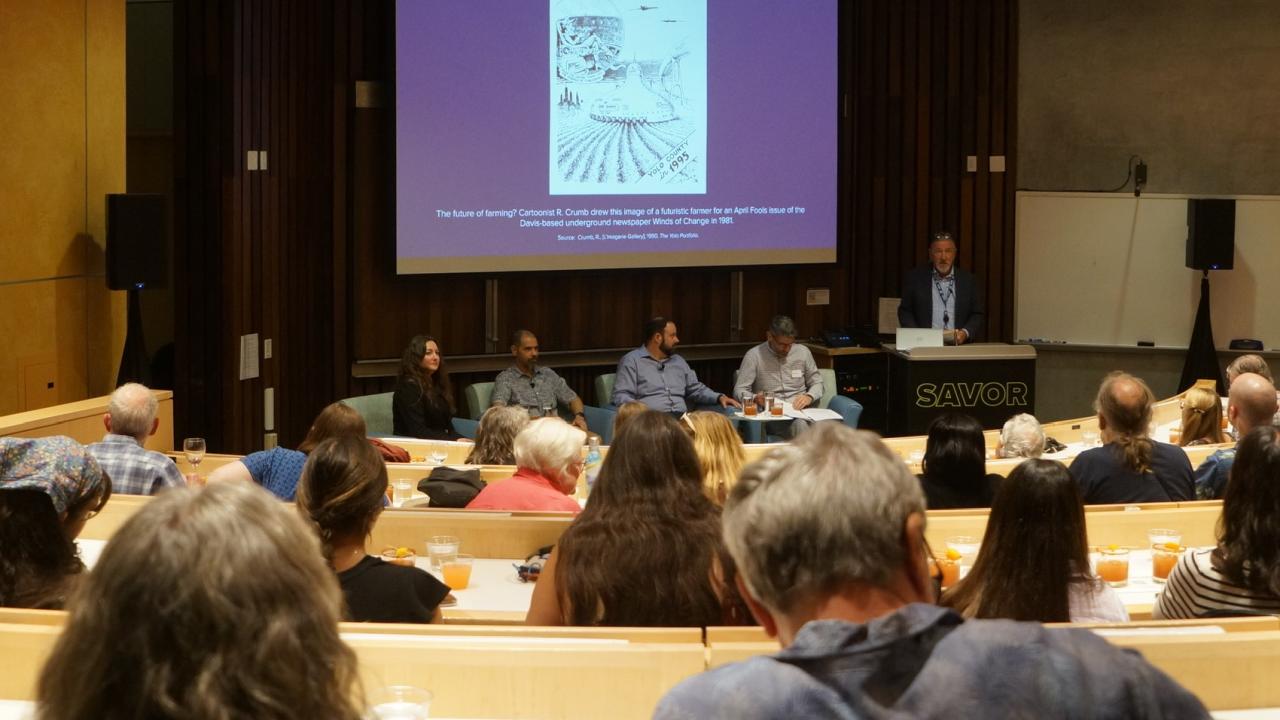
The Strengths and Shortcomings of AI Food Innovation
Food is an unusual topic when it comes to AI (artificial intelligence), but you’d be surprised to know that there are already products that were made with it that are dropping into shopping carts. Last Thursday, Dr. Ned Spang opened up the floor to three experts to discuss where this new innovation is leading us. Although significantly reducing cost and time, will this tool ultimately help or hinder your next meal?
Meet the “RI” Behind AI Chef Morgan
Food and beverage is a popular genre that AI tools are using. About two-thirds of online blogs are food and beverage oriented. Justin Shimek, the CEO and chairman of the food and beverage company Mattson, introduced Chef Insights™ to our audience tonight. These revolutionary AI chefs are built to co-create new products and menu lineups. To demonstrate, Shimek invited community members to a “somewhat structured cocktail hour” and presented a Calamansi and Tamarind Margarita with a Tajin rim. This southeast asian and Latin flavor blend was developed using Chef Insights™. After, he asked Chef Morgan, the AI lead of Chef Insights™, straight from his phone:
“If we can bring a small bite to the party [to complement the margarita], what might you recommend?” Shimek asked on his phone.
“I’d recommend something that balances the sweet, tart flavor. A citrus-infused ceviche with a touch of heat, topped with avocados and served on crispy plantain chips. The freshness and acidity would really complement the drink!” Chef Morgan responded in an almost-human voice.
Forty unique chefs collaborated to create the lead model of Chef Insights™, Chef Morgan. Although this may seem like a lot of knowledge, at Mattson AI, personas are encouraged to be used as a lens, not just a filler chef. “From our perspective, it's all about the artful combination, the real intelligence (RI), with artificial intelligence,” Shimek explains.
The AI Climb Towards Sensory Science
Next, a familiar face to the food science majors presented his case. Dr. Julian Delarue is a sensory and consumer scientist as well as a professor at UC Davis. Although we may see AI in limited spheres, such as pairing unique foods together in product development, Dr. Delarue challenges it one step further.
Flavor is a result of the interaction between the consumer and the food; it’s not necessarily there to begin with. AI’s ability or inability to taste food offers a unique perspective. All senses are extremely specific for people. For example, if one single alpha ionone molecule changes to a beta ionone, the scent can change from smelling like a violet to smelling like a rose. There are more than 25 different types of tongue receptors on the tongue that exclusively pick up bitterness, so just imagine how different each food experience is from one person to another.
Eating is also not just about food. A dining experience can shift depending on the environment and atmosphere of the room, the company at the table, and preconceived notions about the cuisine, which are just a few elements that may contribute to food perception. The task is immense and AI is far from accomplishing any one of these categories; however, Dr. Delarue is hopeful, as he puts it simply, “food for thought”.
AI Myths and Mysteries
The last presenter of the night, Carrie Alexander, gave us insight into how farmers and food producers are taking this. Carrie is a PhD postdoctoral scholar for Socioeconomics, Ethics, and Policy at the AI Institute for Next Generation Food Systems, so her experience through surveying various voices led her towards two myths in this emerging industry.
One may assume farmers would be the most against AI, but in reality, many farmers are accepting and willing to adapt to AI. However, the legal issues that could occur or the gap in technology for specific tasks are a hindrance to this new technology. Another misconception is that as AI develops, the industries using it will as well. Although a portion of this is true, many people expressed their concern about AI leading a wave of human unemployment.
At the end of the day, the food industry is a business. Companies are bound to turn to AI as replacements for potentially cheaper and faster alternatives to workers. Carrie urges us to listen to multiple perspectives and not to ignore this upcoming technology.
What Happens Now?
AI is still far from perfection, but it has so much potential for productivity. As Justin Shimek answered, “AI allows us to be smarter, faster.” AI could give employees the opportunity to focus on creative endeavors rather than mindless tasks. Carrie Alexander brought up that as AI uses an average of data, it shies away from outliers. “I think there could be a risk of losing certain elements of our own creativity if we don’t work hard to keep both,” Alexander stated.
Delarue shared his fondness for sorting sensory data with AI, with a set usually taking days to complete, now instantaneous. Controversially, he encourages his students to experiment with AI models in product development. With any usage of AI, since the technology is so new, we don’t know the long-term effects, but it’s clear we are heading towards a change. We cannot lose sight of AI’s original purpose: to elevate and assist human creativity, innovation, and intellect. Otherwise, we may end up sacrificing those freedoms in the name of "convenience."

Gwen Gonzalez is a fourth-year food science major passionate about storytelling and food innovation. She is an active member of the Food Tech Club on campus and assists in Guinard's Lab pursuing sensory science. When she's not thinking about food, she immerses herself in music and the performing arts at the Manetti Shrem Museum and Mondavi Center for the Performing Arts. In the future, she hopes to merge her interests in food and the arts and contribute to creative research and development in the food industry.
